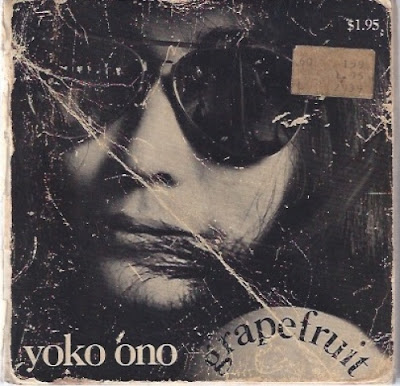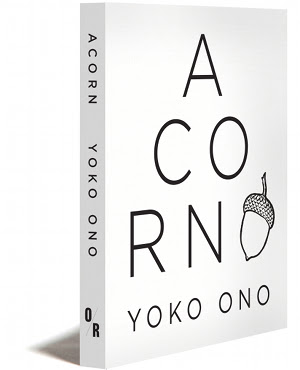Yoko Ono's Sales List from 1965 consisted mostly of fanciful conceptual items that either didn't exist, or couldn't. These included a machine that cries when a coin is deposited and a performance (offered for $2000) that would see your town covered in pink snow ("guaranteed not to be artificial"). The work is typically now understood as a mail art project, or an early example of an artists' conceptual commerce. The list also included Ono's 1964 artist book Grapefruit, which presented a series of "event scores" under the headings of Music, Painting, Event, Poetry and Object.
The book was originally self-published in Japan under the imprint of Wunternaum Press (which wouldn't be resurrected again until 2003, for Ono's book Spare Room).
After Ono's marriage to John Lennon, a second edition was issued in 1970 by Simon and Schuster in New York, Peter Owen Ltd in London, and Bärmeier & Nikel in Frankfurt. This expanded edition contained two new sections (Film and Dance), as well as an introduction by Lennon: "Hi! My name is John Lennon. I'd like you to meet Yoko Ono..."
Paperback versions (published by Sphere and Touchstone) followed shortly afterwards, and then the title was out of print for about thirty years, with prices on the secondary market for the second edition ranging between $80 and $200. A copy of the true first edition (as advertised in Sales List for $10) is currently listed, here for $12,444.00.
Simon & Schuster issued a reprint in 2000 and the title has remained available subsequently. It is considered a classic example of an artists' book and a key Fluxus document, alongside George Brecht's similar Wateryam and the collective An Anthology. Together with those titles, Ono helped introduce the concept of the "event score". Music fans know the book as the origin of Lennon's signature song Imagine, as many of the texts in the book begin with the instruction to "Imagine..."
The book was also instrumental in the couple's courtship. After a couple of meetings, Ono sent Lennon a copy in the mail, which he reported kept on his nightside table. In later interviews he described reading from it and being alternately exasperated and delighted by it.
The Sales List also offered the sequel to the book, titled Grapefruit II, which was listed as including over 200 compositions not included in the original book. It was slated for publication the following year, in 1966, and was being offered at a pre-publication price of $5.00.
The book was never produced, and presumably many of the 80 new scores in the 2nd expanded edition came from this planned follow up.
Almost half a century later, the sequel was announced last month. Now titled Acorn, the 216-page book is being published by OR books, a smaller press that utilizes print-on-demand technologies and (according to it's website) "embraces progressive change in politics, culture and the way we do business."
Acorn continues the instructional poetry of Grapefruit (or “poetry in action with participation” as Ono now calls it) and is illustrated with 100 of Ono's black and white drawings. She says in the introduction to the book:
"It’s nearly 50 years ago that my book of conceptual instructions Grapefruit was first published. In these pages I’m picking up where I left off. After each day of sharing the instructions you should feel free to question, discuss and/or report what your mind tells you. I’m just planting the seeds."
Grapefruit was reportedly chosen as the title for her first book because Ono imagined a grapefruit to be a hybrid of an orange and a lemon, and thought of herself as a "spiritual hybrid". A few years prior, in 1961, Ono had presented a performance at Carnegie Recital Hall called A Grapefruit in The World of Park: A Piece for Strawberries and Violin.
The title Acorn presumably refers to one of the earliest public events Ono and Lennon produced together, in 1968. Invited to contribute to the National Sculpture Exhibition at Coventry Cathedral, the pair proposed planting acorns as living sculptures. Ono's would face East and Lennon's West. When the original acorns were dug up by zealous fans searching for souvenirs, two replacement acorns are planted, with a guard assigned to protect them. Following this, pairs of acorns were sent to world leaders, who were requested to plant them as declarations of peace.
The Beatles song The Ballad of John and Yoko, here, refers to the episode with the verse "Caught the early plane back to London/Fifty acorns tied in a sack/The men from the press said/We wish you success/It's good to have the both of you back".
Acorn will be available as both a trade and deluxe signed edition. The paperback will retail for $16, the E-book for $10 and the deluxe for $280.00. The latter is clothbound, in a slipcase and is produced in a signed edition of 285 copies. A portion of the proceeds from the deluxe edition will be donated to the advocacy organization Autism Speaks.























The collector's edition finally shipped out to those who pre-ordered. I received mine on 1 August and made an unboxing video!
ReplyDeletehttp://www.youtube.com/watch?v=JM0i6cfDQfg